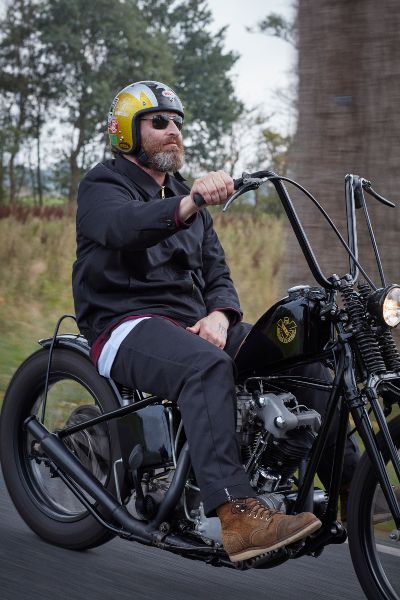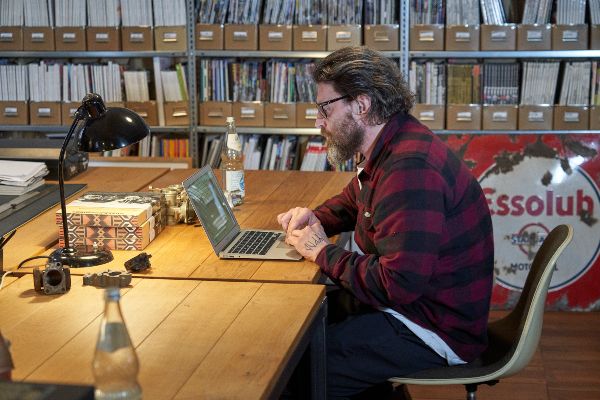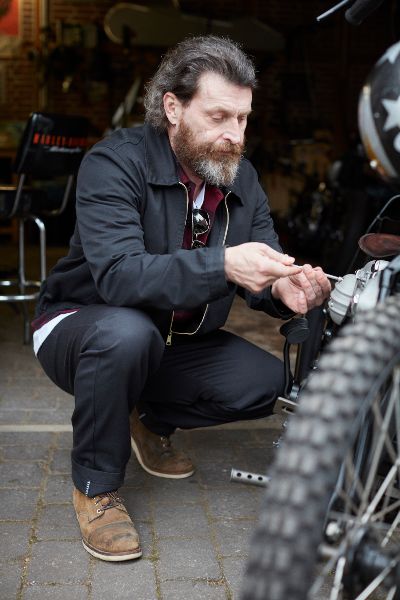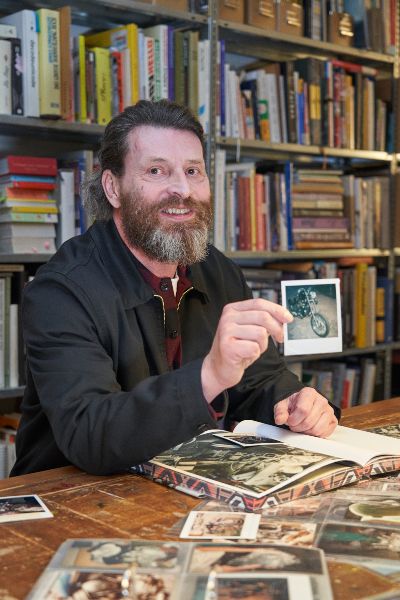Meet Uwe Ehinger, motorcycle builder and gin producer
MEET THE MAKERS| 21.01.2021
At Dickies we recognise the art of work, so we created our Meet The Makers series to give an insight into the individuals who’s spirit of creativity takes the common idea of work to explore the passion and drive behind it.
For our latest featured Independent Makers film, we visited Uwe Ehinger, the creator behind Ehinger kraftrad . We caught up with him as he took us on a tour round his amazing showroom and workshop and talked us through the materials and technology he uses as part of his creative process and how he brings his idea to life.
Hi Uwe, thank you for spending the day with us in the space you work in. Let’s go back to the beginning, can you give us a bit of background information on yourself and where this all started for you?
My name is Uwe Ehinger and I’m a creative. I come from motorcycling, I started with it in 1974 when I was little, that’s also how my creative process began. I’ve dealt with many motorcycles… hundreds and thousands of motorcycles. In South America, South Korea, around the entire world. Now I’m basically at a point where I use the motorcycle, in the best sense if you will, to continue working on creative projects. That goes from a gin we’ve created, and in everything else I do in design, I try everything. I’m currently in the process of getting an idea on how I could create a house. And that is basically what I want, I still want to go a step further in my art and create what satisfies me.
The pieces you make are very interesting, it would be great to get an insight into your creative process, could you tell us about how you come up with your ideas?
A part of my creativity lays in the fact that I don’t conform to any single rule, I’ve never done so. The perfect example of this is the oil tank on the snowracer which is absolutely senseless and pointless because it is milled out of a solid block of aluminium, then it has been cut in pieces and welded back together.
This is what I want to show, that I change things that are actually there, it’s not revolution it’s evolution.
I try to achieve this with my creativity, this is extremely important to me. When I can do this I feel good and then everything is good. There are also many people who recognise this and that makes me very happy, the others who don’t get it that’s really alright. I’m just really thankful that I even have the opportunity.


That is so interesting, we would love to know what happens after the idea stage to bring your creations to life?
I have a million ideas I would like to make a reality. I would be grateful if I could build all the bikes that are in my head. The process of building a bike for me is rather difficult and the computer helps massively to speed things up. So this is what I do, I basically use money and computers, or drawings or whatever, to bring my creative project as fast as possible somehow onto paper and quickly make it a reality because I want to see it and this all happens relatively quickly. The most difficult thing is to have the patience until some things are finished and I am very impatient. I would love to do a thousand things at once. I always want to create something from morning to evening.
One thing we have really found interesting and quite unusual is your use of modern technology as well as vintage processes. Could you tell us a bit about this?
I like to use computers since a picture tells more than a thousand words and especially when you’re in a team it’s really important to visualise your ideas so everyone is on the same page. And for that the computer is really ideal these days. I also use computers technologically of course, since things can also be simulated, especially when it comes to cylinder head optimisation, it’s a mighty tool. Or even when we make an air filter or whatever, it makes sense from a cost perspective to make it on the computer first. It’s the modern world, and we should be thankful and glad that we have these possibilities and own these tools and of course I use them.


Something that really caught our eye is the range of ideas you bring to life, could you tell us a bit about some of your concepts?
A good example of my kind of work is also the gin as a concept, but it’s not just gin, it’s a bottle with an artefact, in this case a motorcycle part, and this bottle can be filled with gin and that’s the big difference. The next might be that I take an artefact, a camshaft of a Russian motorcycle, this case a WR and then we’ll fill the bottle with vodka or I have one of my knuckleheads that I’ve found in Mexico and put tequila in it. And that’s the big conceptual difference or the crucial conceptual difference. As I said, you can use this for everything, you can use this for any brand such as Dickies to fill the bottle with whatever fits logically and what the team thinks is the right thing. And that is in principle how I work.
You are a very talented and accomplished bike builder, what in your opinion are the differences in how you build your bikes compared to other builders?
The best example I have is the new black bike I’ve built. It’s a mixture of 1937, 1936 and 1929, I’ve used the lightest components, a modern compressor with side valves and a JD fork from the 20’s because it’s the absolute lightest you can get, a relatively modern Honda XL 500R brake, this really shows what myself and the team want to build, the ideal bike of the past and the future, all in one. That in itself might not be understood by everyone, many don’t like it because you use old things and that you of course should treat a different way, because they might be too valuable in some way but I don’t see it like that, that’s absolutely the example of how I work, how I think and how I like to create things.


You must have so many stories and so much information with your history in bike building, how can we find out more?
We have also created a great book with the team at Studio Oeding. Which was fantastically designed by Katrin, I shot all the pictures myself and I’m proud of it. Everything was analogue not digital which was an extremely hard process, I still have 6000 pictures and we used 600 in the book. I’m happy that this gives me the opportunity to really show people what we’ve done back in the day. A wonderful print and the pictures are a lot better than I could have ever imagined, the look has really become beautiful over the years. It’s a great thing and I’m grateful that I can show something like this and people can get an impression of what happened back then. Over the entire world by the way. That’s really a great thing. I’m really glad about it.


